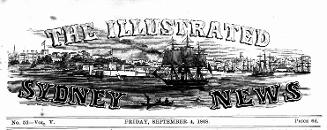 242133804699832181.png
242133804699832181.png
 242133804699832181.png
242133804699832181.png
This issue of The Illustrated Sydney News also includes:
An advertisement for items to be included in the Illustrated Sydney News Almanac for 1869.
The 'Colonist' writes to refute the claims, reported by the Illustrated Sydney News, that rumours of Dr William Bland's deathbed conversion to Roman Catholicism were slanderous and wholly unfounded. The 'Colonist' contends that Bland did, in fact, receive a 'conditional baptism' as a Roman Catholic and that he was subsequently visited by members of the Roman Catholic clergy.
In a footnote to the letter, the News's editor admit's the use of the word 'slanderous' was wrong, but notes that the 'Colonist' gives 'no proofs or references to any one was present at the ordination to which he alludes'.
A review of bound volumes of the Australian Journal (vol. 3), Sydney Punch (vol. 8) and the Colonial Monthly (vol. 1), and of William Carleton's poetry collection The Warden of Galway.
Extract from accompanying text: 'The portrait of H. R. H. Prince Alfred 'which is considered one of the best ever taken in Australia, is from the studio of Mr. Bradley, and represents the Prince reading our humourous contemporary Sydney Punch, whose fine cartoon, 'Australia Vindex,' has been considered in England as justly expressing our detestation of the attack on the life of our royal visitor'.
A column detailing the establishment of the Melbourne Public Library (later, the State Library of Victoria) including information on funding, collections and building dimensions.
The Illustrated Sydney News reports on the departure of W. S. Lyster's Opera Troupe. The troupe had been in the colonies since 1861 and 'three of their number rest in Australian soil'.
An advertisement for several of 'Partridge's Illustrated Publications', including Mary E. B. Howitt's Our Four-Footed Friends (1867) and the periodicals British Workman, Children's Friend, Band of Hope Review, The Infant's Magazine, The Friendly Visitor and The Servant's Magazine.
The publishers of the Times advise that they have become the proprietors of the newspaper 'hitherto known as the Evening Mail'. From 20 June 1868, the newly acquired newspaper will be known as The Mail and published twice weekly.